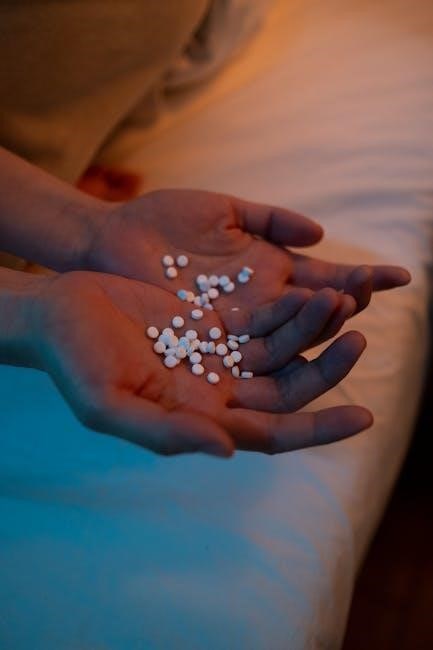
levels of care mental health pdf
Mental health care encompasses a continuum of services. These services vary in intensity, frequency, and duration. The levels address the severity of an individual’s symptoms. Understanding these levels helps in choosing appropriate treatment options.
Defining Levels of Care in Mental Health
In mental health, “levels of care” refers to a structured system. This system comprises various psychiatric services designed to meet diverse needs. These levels are differentiated by the intensity of care a person receives. Treatment begins with evaluating mental health and daily living skills. This evaluation determines the appropriate level of support needed. The levels range from outpatient therapy, the least intensive, to acute inpatient care, the most intensive. These encompass individual counseling and medication management.
Intensive outpatient programs (IOPs) and partial hospitalization programs (PHPs) offer structured support. Residential treatment provides a supportive living environment alongside therapy. Acute inpatient care offers 24-hour skilled nursing and medical care. The aim is to match the intensity of services to the individual’s specific needs. This tiered approach ensures that individuals receive tailored and effective treatment. Moreover, a continuum of care facilitates smooth transitions between these levels.

Outpatient Care
Outpatient care is the least intensive level of mental health support. It typically involves regular meetings with a therapist. Issues like self-esteem, divorce, and work problems are addressed.
Individual Counseling (Routine Outpatient Care)
Routine outpatient care represents the foundational level of mental health treatment. It primarily involves individual counseling sessions with a therapist. These one-on-one sessions provide a safe and confidential space for individuals to explore their thoughts, feelings, and behaviors. This therapeutic approach focuses on addressing various challenges, including relationship issues, stress management, and personal growth.
During individual counseling, clients work collaboratively with their therapist to identify goals and develop coping strategies. The frequency and duration of sessions are tailored to meet the specific needs of each individual. Routine outpatient care is suitable for those who can maintain their daily routines while seeking support for their mental well-being.
This level of care is often the first point of contact for individuals seeking mental health assistance. It provides accessible and flexible support. It allows individuals to integrate therapy into their existing lifestyles. It also promotes long-term mental wellness.
Medication Evaluation and Management
Medication evaluation and management is a crucial component of outpatient mental health care. This service involves a comprehensive assessment by a qualified psychiatrist or psychiatric nurse practitioner. The evaluation aims to determine if medication is an appropriate and beneficial part of the individual’s treatment plan. Factors considered include the individual’s symptoms, medical history, and any potential side effects.
If medication is prescribed, ongoing management is essential. This includes regular follow-up appointments to monitor the medication’s effectiveness and adjust dosages as needed. The provider also addresses any concerns or side effects experienced by the individual. Effective medication management requires a collaborative approach between the provider and the individual. It ensures optimal outcomes and promotes overall well-being.
This level of care focuses on the safe and responsible use of psychotropic medications. It helps individuals achieve symptom relief and improve their quality of life. It also plays a critical role in stabilizing mental health conditions.

Intensive Outpatient Programs (IOPs)
Intensive Outpatient Programs (IOPs) offer a structured treatment approach. They are designed for individuals needing more support. IOPs provide several weekly therapy sessions. This offers a step up from standard outpatient care.
Characteristics of IOPs
Intensive Outpatient Programs (IOPs) bridge the gap between traditional outpatient therapy and inpatient care. IOPs are characterized by their structured approach. They typically involve multiple therapy sessions per week. These sessions can include individual and group therapy. IOPs offer a supportive environment for those needing more intensive treatment. They are designed for individuals who do not require 24/7 supervision.
IOPs address issues like school or work difficulties. Friendship issues and self-esteem challenges are also discussed. Divorce-related stress can be managed within this framework. The goal is to improve mental health. Clients also improve daily living skills. IOPs help individuals maintain their independence. They can live at home while receiving treatment. The programs provide a higher level of support. IOPs are a valuable part of the continuum of mental health care.

Partial Hospitalization Programs (PHPs)
Partial Hospitalization Programs (PHPs), also known as day treatment, offer structured mental health support. PHPs provide intensive therapy and medical services. They are designed for individuals needing more than outpatient care.
PHP as Day Treatment
Partial Hospitalization Programs (PHPs) function as day treatment programs, providing a structured therapeutic environment. Individuals attend PHP during the day and return home in the evenings, facilitating a balance between intensive treatment and maintaining connections with their home environment. This level of care is designed for those requiring more support than routine outpatient services but do not need 24-hour inpatient care. PHPs typically include individual and group therapy, medication management, and skills-based training. These programs address various mental health conditions, aiming to stabilize symptoms and improve overall functioning. The goal is to equip individuals with coping mechanisms. It helps them transition to lower levels of care. PHP offers comprehensive support while allowing individuals to live at home.

Residential Treatment
Residential treatment provides structured mental health care in a live-in setting. It offers intensive therapy and support for individuals needing a higher level of care than outpatient or day programs can provide.
Features of Residential Mental Health Care
Residential mental health care offers a structured and supportive environment. It is designed for individuals who require more intensive treatment than outpatient settings can provide, but do not need the acute medical care of inpatient psychiatric units. These programs offer 24/7 support. This includes therapeutic interventions, skill-building activities, and medication management.
Residents engage in individual and group therapy sessions. They also participate in various activities aimed at promoting emotional, behavioral, and psychological well-being. The duration of stay varies. It depends on individual needs and progress. A multidisciplinary team tailors treatment plans.
The environment is designed to be safe and nurturing. This fosters healing and personal growth. The goal is to equip residents with the tools and strategies needed to manage their mental health effectively and transition to a less intensive level of care. Residential treatment bridges the gap between acute hospitalization and independent living.

Inpatient Psychiatric Care
This level provides structured, 24-hour care. Skilled nursing and medical services are continuously available. It is the highest intensity of care. The environment ensures safety and constant monitoring for patients.
24-Hour Skilled Nursing and Medical Care
Inpatient psychiatric care provides round-the-clock skilled nursing. It also offers comprehensive medical care. This level represents the highest intensity of support within a structured setting. Patients receive continuous monitoring and immediate access to medical professionals. This is crucial for individuals experiencing severe mental health crises. The structured environment ensures safety and stability, minimizing risks associated with acute symptoms.
The focus is on stabilizing the patient’s condition. Interventions include medication management, therapeutic interventions, and crisis management. A multidisciplinary team collaborates to create individualized treatment plans. These plans address the unique needs of each patient. The constant availability of care allows for prompt intervention and adjustment of treatment strategies.
This level of care is designed for those requiring intensive support. It is a safe and therapeutic environment for recovery.

Acute Inpatient Care
Acute inpatient care is a high-intensity mental health service. It’s designed for individuals experiencing severe and destabilizing symptoms. These symptoms often pose immediate risks to themselves or others. This level of care provides a secure and structured environment. It ensures constant monitoring and intervention by mental health professionals. The primary goal is to stabilize the patient’s condition. This involves managing acute symptoms and preventing harm.
Treatment typically includes medication management and intensive therapy. Crisis intervention is also crucial. The focus is on rapid assessment and diagnosis. The inpatient setting allows for continuous observation. This enables timely adjustments to treatment plans; A multidisciplinary team works collaboratively. They address the complex needs of patients during this critical phase.
Acute care is a short-term intervention. It aims to transition patients to lower levels of care. This happens once they are stable and safe.

Factors Determining Level of Care
Determining the appropriate level of care involves evaluating a person’s mental health. It also involves evaluating their ability to perform daily living skills. Overall safety of self and others is paramount.
Evaluation of Mental Health and Daily Living Skills
The initial step in determining the appropriate level of mental health care involves a comprehensive evaluation. This assessment focuses on the individual’s current mental state, encompassing the severity and nature of their symptoms. Mental health professionals assess various factors, including mood, thought processes, and the presence of any psychiatric disorders.
Furthermore, the evaluation extends to assessing the individual’s capacity to perform essential daily living skills. These skills include personal hygiene, meal preparation, household chores, and managing finances. The ability to maintain employment or attend school is also considered. Deficits in these areas can indicate a need for a more structured and supportive environment.
The evaluation also considers the individual’s safety and the safety of those around them. This includes assessing for suicidal or homicidal ideation, as well as any history of aggressive behavior. A thorough evaluation ensures that the recommended level of care adequately addresses the individual’s needs and promotes their well-being.

Continuum of Care
Mental health care is provided across a continuum. This system ensures individuals receive appropriate support. The intensity adjusts based on their needs. This approach ensures effective treatment and promotes long-term well-being.
Moving Between Levels of Care
Individuals may transition between different levels of mental health care. This depends on their evolving needs and progress. Movement isn’t always linear; someone might step up or down. Adjustments are based on symptom severity, daily functioning, and safety. The goal is to provide the least restrictive, yet most effective, environment.
Regular assessments determine if a change is necessary. Factors include treatment response and ability to manage daily life. A collaborative approach involving the individual, therapist, and psychiatrist is crucial. This ensures a smooth transition and continued support.
For instance, someone improving in inpatient care might move to an IOP. Conversely, worsening outpatient symptoms may necessitate PHP. The continuum allows for flexibility and personalized care. The ultimate aim is sustained recovery and improved quality of life.

Other Mental Health Care Settings
Beyond the primary levels, various specialized mental health settings exist. These cater to specific needs and populations. Community mental health centers offer comprehensive services. These often include case management and crisis intervention. Support groups provide peer interaction and shared experiences.
Telehealth expands access, especially in underserved areas. School-based programs address mental health in educational settings. Assertive Community Treatment (ACT) teams deliver intensive, community-based support. This is for individuals with severe mental illnesses.
Crisis stabilization units offer short-term care during acute episodes. Dual diagnosis treatment centers integrate mental health and substance abuse services. Each setting plays a vital role in the mental health ecosystem. They ensure individuals receive tailored support. Selecting the right setting is vital for effective recovery.